Charging the Plug-in Prius with Solar Power
Summary
- The "Sunny Boy" 4kW inverter has a "secure power supply" that is
specified to provide 1500W if the grid goes down.
- According to my measurements, the Prius takes about 1250W at 11.6A to
charge from a normal wall outlet.
- It should be possible to simply plug the Prius charging cable into the
"secure power supply" but for whatever reason the inverter is unwilling to
supply enough power and cuts out.
- By connecting a 12V "bucking" transformer in series with the inverter
output, it reduces the Prius charging current to under 11A, which the
inverter can handle. This allows the Plug-in Prius to receive a full
charge on solar power.
Details
When specifying the solar installation at the house in Arizona with the
installer, one of the requirements was to be able to run essential equipment
during a grid failure. I suggested using five 4kW inverters instead of the
somewhat less expensive option of a single 4kW and two 7kW units. That was
because the "Sunny
Boy" inverters he recommended each have what they call a "secure power
supply" capable of supplying 1500W of off-grid power. For a modest cost
increment, I would have five "secure power supplies" instead of just three, and
a full 7.5kW to keep my ice cream from melting. Just as important, the
1500W specification implied that I could charge my Plug-in Prius from any one of
the inverters simply by plugging the Prius charging cable into its outlet.
Whoopsie. I was very distressed to discover that, for whatever reason,
the "secure power supply" didn't quite meet spec. I would plug in the
Prius, the current would ramp up, the inverter would cut out, and I would spend
a few minutes staring incredulously at my trusty Kill-A-Watt wondering what was
wrong while the process automatically repeated.
Making a very long, tedious, well-documented series of measurements and
volumes of correspondence with the inverter manufacturer, SMA-America into this
one-paragraph note, I ended up agreeing with myself and vehemently disagreeing
with the manufacturer who claimed that the Sunny Boy was just fine and I must be
wrong.
Unfortunately, ge tting the manufacturer to do something about the power
shortfall was (and may continue to be) a difficult task. Invoking the
"life is too short" clause, I decided to do something about it myself. I
hypothesized that if I could somehow reduce the Prius charging power, I would be
able to use the inverter as intended. While I haven't found any detailed
information on the Prius charging system, I guessed that charging it at 100V
would reduce the power demand even as it increased the charge time by an amount
equivalent to the percentage voltage reduction. (This is a logical but not
foregone conclusion; some power supplies take more current as the voltage input
decreases, Fortunately, the Prius isn't one of them.)
To reduce the input voltage, I went to the local Home Depot and picked up a
landscape lighting "power pack." Although it was much too fancy for this
application, it allowed one to bypass the photocell and digital timer and still
produce 12VAC at 200 watts. By connecting this in a series "bucking"
arrangement with the AC line, I was able to reduce the power demand from the
Prius charger to 1200W and 10.78A which the inverter was able to handle.
The graphics below the solar panel outputs before and during the Prius
charging.
|
 |
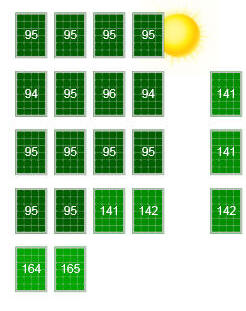 |
|
Normal grid-tie operation - Panels producing
maximum power on this sunny mid-November day. |
One solar inverter disconnected from the Grid and
the "Secure Power Supply" switched on. Prius is now charging from
the inverter AC outlet. Readouts below show power being delivered
to the Plug-in Prius charging cable. |
|
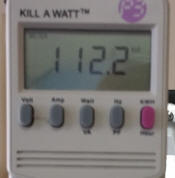 |
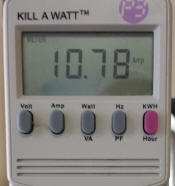 |
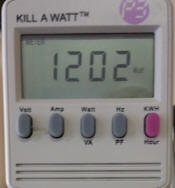 |
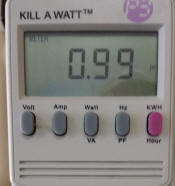 |
| Inverter voltage 112.2 volts |
Inverter current 10.78 amps |
Inverter power 1202 Watts |
Load power factor .99 |
|
 |
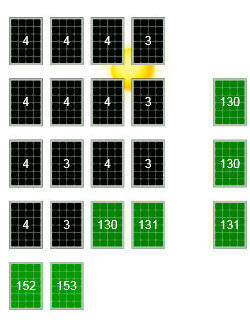 |
|
Prius almost completely charged - charging power
decreases. |
Prius now fully charged, only remaining current
drain is from parasitic load of 12V transformer. |
I made an interesting if minor discovery. Right before the Prius
completes its charging, the power decreases by almost half. Presumably
this facilitates measuring the charge state of the Prius lithium battery pack
and may "top off" the charge. I've never seen it discussed in the Prius
information I've found on the internet.
| This is the temporary test setup I used to confirm that I could
charge the Prius. The block at the bottom left is the "power pack"
that delivers 12VAC at 200 W. It's connected in series "bucking"
with the Prius charging cable at the right. |
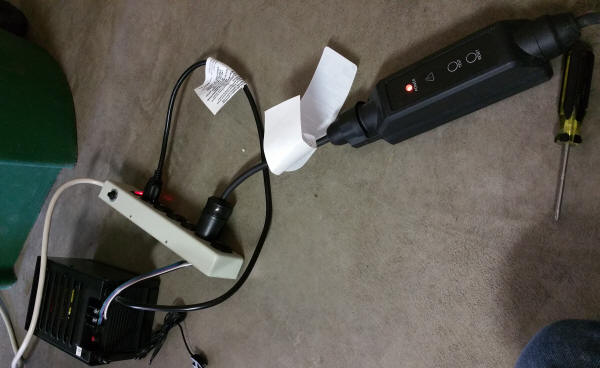 |








